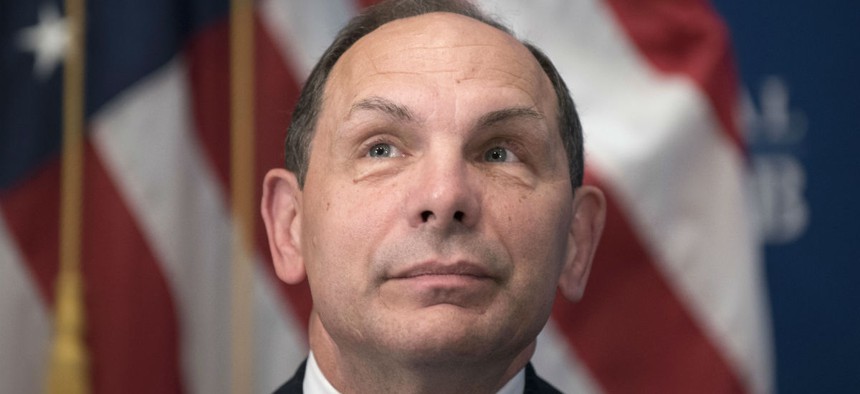
Secretary Bob McDonald spoke at the National Press Club on Friday. Sait Serkan Gurbuz / AP
VA Has Already Fired 400 More Employees This Year Than Last
Bob McDonald said VA has fired 1,500 employees this calendar year compared to 1,100 people in 2014.
The Veterans Affairs Department has fired 400 more employees this year so far than in 2014, according to Secretary Bob McDonald.
McDonald said VA has fired 1,500 employees this calendar year compared to 1,100 people last year – a 36 percent increase. The former head of Procter and Gamble added that 2,280 employees have been terminated since his confirmation as VA secretary in July, and that the department has proposed disciplinary action against 300 workers for “manipulating scheduling.”
The VA has a workforce of roughly 330,000 employees. VA fired 2,247 employees for disciplinary or performance reasons in fiscal 2013, more than any other Cabinet-level agency, according to data from the Office of Personnel Management. That amounted to about 0.7 percent of its workforce.
An Oct. 15 report from the VA to the House and Senate Veterans’ Affairs Committees lists “adverse employment actions” including firings initiated since June 3, 2014 on “any basis related to patient scheduling, record manipulation, appointment delays, and/or patient deaths.” According to the report, proposed disciplinary action for about two dozen employees was related to cases specifically involving the patient wait time manipulation scandal.
Last year, it came to light that department employees at the Phoenix VA medical facility had falsified patient data to cover up severe delays in scheduling medical appointments for vets. Those problems cost former VA Secretary Eric Shinseki his job and sparked a management overhaul by McDonald, his successor. Similar issues have cropped up elsewhere throughout the department, in addition to instances of mail and claims mismanagement, retaliation against whistleblowers, allegations of overprescription of opioids, and controversies over senior executives’ compensation.
The 2014 Veterans Access, Choice and Accountability Act made it easier to fire senior executives at the department; legislation pending in Congress now would make it easier to fire the rest of the VA workforce.
The subject of accountability and the firing statistics came up during McDonald’s appearance at a National Press Club lunch in Washington on Friday.
“Now, I have to say that accountability is a lot more than firing people,” McDonald said in response to a question after his remarks. “It’s also about giving people the responsibility, giving them the training, and then working with them and training them to perform at a higher level.”
The VA secretary said the department has incorporated “improving customer service” and other “MyVA” transformation goals into employees’ performance plans. “So, we’ve made progress, we’ve got a lot more to do,” McDonald said, after mentioning in his speech the various training initiatives underway for employees at the department. “There’s lots of investigations currently under way, and as time goes on, you will see the results of these investigations,” he added, referring to proposed disciplinary actions against employees.
On Monday, the House Veterans' Affairs Committee held a contentious hearing involving two senior executives who, according to the department watchdog, used their positions of authority for personal and financial gain. Diana Rubens and Kimberly Graves appeared under subpoena at Monday’s hearing but did not answer the committee’s questions, invoking their Fifth Amendment right against self-incrimination. The VA has proposed punishment for the two, but has not yet announced what that punishment is.
McDonald on Friday acknowledged the challenges the VA still faces in providing quality and timely care to veterans, but he spent most of the time ticking off the department’s accomplishment since the 2014 wait times and records manipulation scandal erupted. The “net staff” at the Veterans Health Administration is now “up over 15,000,” he said, and the department completed 1.4 million claims in fiscal 2015 – 67,000 more claims that last year. The department’s wait times for vets seeking medical appointments also has improved, according to McDonald: 97 percent of appointments are scheduled within 30 days; 92 percent are within 14 days; 87 percent are within a week; and 23 percent are same day.
McDonald said he has suggested to congressional committee leaders that “we hold a hearing on the MyVA transformation rather than continue the barrage of hearings we’ve had on things that occurred two years ago.”
NEXT STORY: Can Gen X Succeed at Work?







